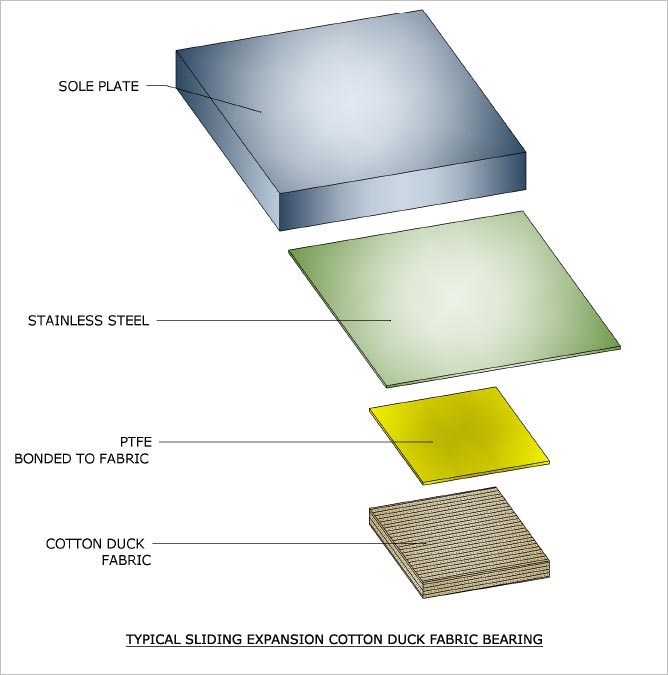Cotton-Duck Fabric Bearings
INTRODUCTION
Cotton Duck Fabric Bearings are a layered rubber and cotton duck fabric bearing that can be used in a wide variety of structural bearing applications. They go by many names such as Fabric Bearings, Preformed Fabric Bearings, Cotton Duck Pads and Cotton Duck Bearings. They can have a sliding surface of PTFE and stainless steel for a Sliding Expansion Bearing (see example) or can be plain without sliding surfaces. These bearings are well suited when very little relative rotation can be expected (equal to or less than 0.003 radians) and where they will sustain no more than 2500 psi of compressive stress. Except for Sliding Expansion Bearings (where movement is accommodated by the sliding PTFE/Stainless surface), they are not well suited if the movement is expected to be accommodated by shear of the fabric pad.
These bearings have a relatively low initial cost and are low maintenance.

STANDARD BEARINGS
The following are the Standard Cotton Duck Fabric Bearing configurations:


DESIGN
While AASHTO specifications allow one design approach (Method “A”, Section 14) many states have superimposed their own limitations on the design process. Local requirements should be checked before commencing design.
MATERIALS
The Cotton Duck Fabric Pads used in our bearings conform to AASHTO Section 18.4.9.1 and any other State Specifications for bearings.
Other material specifications include ASTM A240 Type 304 and Type 316 stainless steel with a #8 mirror finish and ASTM D4894 for the PTFE.
STRUCTURAL DESIGN CONSIDERATIONS
Bearings are normally mounted with their short side parallel to the girder axis for maximum rotation capacity. Friction is usually sufficient to keep bearings in place, but if minimum loads are light, then a slippage check must be made.
If positive location is required, bonding of the pad to steel plates is suggested (See Figure 1).

INSTALLATION
Seating on flat, broom-finished concrete, free of voids, or on mill-finished steel plate is satisfactory. If a grout pad is specified it should be a high-strength non-shrink material. Epoxy grout may serve to correct seating inaccuracies. By placing bearing and beam before the epoxy has set, excess epoxy will be extruded from high spots and remain in voids. Loading subsequent to the epoxy setting, will then be distributed evenly.
If formwork is erected around a bearing for poured-in-place construction, allowance must be made for bearing compression to avoid jamming the formwork.
Note that if the welding of attachment plates is contemplated, caution must be exercised to prevent temperatures exceeding 250° F/130° C at the pad/steel interface. Temperatures above this may damage the pad.
